Bird R.B., Stewart W.E., Lightfoot E.N. Transport Phenomena
Подождите немного. Документ загружается.


s20.4 Boundary Layer Mass Transport with Complex Interfacial Motion
637
(b)
To get the surface-averaged value of the mass flux, we integrate the above expression
over all
8
and
4
and divide by the sphere surface:
R
sin
8 d8
d+
In going from the second to the third line, we made the change of variable cos
8
=
u,
and
to get the fourth line, we factored out
(1
-
u)
from the numerator and denominator. Equa-
tion 20.3-28 was cited in
Eq.
18.5-20 in connection with absorption from gas bubbles.' This
equation is referred to again in Chapter 22 in connection with the subject of mass transfer
coefficients.
520.4
BOUNDARY LAYER MASS TRANSPORT WITH
COMPLEX INTERFACIAL
Time-dependent interfacial motions and turbulence are common in fluid-fluid transfer
operations. Boundary layer theory gives useful insight and asymptotic relations for these
systems, utilizing the thinness of the concentration boundary layers for small
9,,
(as in
liquids) or for flows with frequent boundary layer separation (as at rippling or oscillating
interfaces). Mass transfer with simple interfacial motions has been discussed in 918.5 for a
laminar falling film and a circulating bubble, and
in
Example 20.1-4 for a uniformly ex-
panding interface. Here we consider mass transfer with more general interfacial motions.
Consider the time-dependent transport of species
A
between two fluid phases, with
initially uniform but different compositions. We start with the binary continuity equa-
tion for constant p and
9,,
(Eq.
19.1-16,
divided by p):
We now want to reduce this to boundary layer form for small %,,, and then present so-
lutions for various forced-convection problems with controlling resistance in one phase.
We use the following boundary layer approximations:
(i)
that the diffusive mass flux is collinear with the unit vector
n
normal to the
nearest interfacial element. (This approximation is used throughout the bound-
ary layer sections of this book. Higher-order approximations: not treated here,
are appropriate for describing boundary layer diffusion near edges, wakes, and
separation loci.)
9.
G.
Levich,
Physicochemical Hydrodynamics,
Prentice-Hall, Englewood Cliffs, N.J.
(1962),
p.
408,
Eq.
72.9.
'
J.
B.
Angelo, E.
N.
Lightfoot,
and
D. W.
Howard,
AKhE Journal,
12,751-760 (1966).
*
W.
E.
Stewart,
J.
B.
Angelo,
and
E.
N.
Lightfoot,
NChE Journal,
16,771-786 (1970).
W.
E.
Stewart,
AKhE
Journal,
33,2008-2016 (1987); 34,1030 (1988).
J.
Newman,
Electroanal. Chem. and Interfacial Electrochem.,
6,187-352 (1973).

638
Chapter
20
Concentration Distributions with More Than One Independent Variable
(ii) that the tangential fluid velocity relative to the interface is negligible within the
concentration boundary layer. (This approximation is satisfactory for
fluid-fluid systems free of surfactants, when the interfacial drag is not too
large.)
(iii) that the concentration boundary layer along each interface is thin relative to the
local radii of interfacial curvature.
(iv)
that the concentration boundary layers on nonadjacent interfacial elements do
not overlap.
Each of these approximations is asymptotically valid for small
9,,
in nonrecirculating
flows with nonrigid interfaces and nonzero Dw,/Dt-that is, with time-dependent con-
centration as viewed by an observer moving with the fluid. The systems considered
in
part (a) of
520.3
are thus included, because they are time-dependent for such an observer
(though steady for a stationary one).
Interfacially embedded coordinates are used in this discussion, with a piecewise
smooth interfacial grid as in Fig. 20.4-1. Each interfacial element in the system is perma-
nently labeled with surface coordinates (u, w), and its position vector is r,(u, w, t). Each
point in a boundary layer is identified by its distance
y
from the nearest interfacial point,
together with the surface coordinates
(u,
w)
of that point. The instantaneous position
vector of each point
(u,
w,
y)
at time t is then
relative to a stationary origin, as illustrated in Fig. 20.4-2. The function r,(u, w, t) gives
the trajectory of each interfacial point (u, w, O), and the associated function n(u, w,
t)
=
(d/dy)r gives the instantaneous normal vector from each surface element toward its posi-
tive side. These functions are computable from fluid mechanics for simple flows, and
provide a framework for analyzing experiments in complex flows.
Drop
1
Drop
2
Composite
drop
Fig.
20.4-1.
Schematic illustration of embedded coordinates in a simple coa-
lescence process.
W.E.
Stewart,
J.B.
Angelo, and
E.N.
Lightfoot, AIChE Jour-
nal, 14,458467 (1968).

s20.4 Boundary Layer Mass Transport with Complex Interfacial Motion
639
Time
t
'
4'
Time
t
origin
of
//
A
Stationary
4
I+
dy
coordinates
&'
Fig.
20.4-2.
Element dS (shaded) of a deforming interfacial area shown at two different times,
t' and
t,
with the adjacent boundary layer. The vectors are (at time t):
8'
=
r&u, w,
t)
=
position vector of a point on the interface
8
=
yn(u, w,
t)
=
vector of lengthy normal to the interface locating a point in
the boundary layer
+
OQ
=
r(u,
W,
y,
t)
=
position vector for a point in the boundary layer
The element of interfacial area consists of the same material particles as it moves through
space. The magnitude of the area changes with time and is given by dS
=
1
2
du
X
Similarly, the magnitude of the volume of that part of the boundary layer between y and
y+dyisdV=
The instantaneous volume of a spatial element
du
dw dy in the boundary layer (see
Fig.
20.4-2) is
dV
=
vg(u,
W,
y, t) du dw dy
(20.4-3)
in which dg(u, w,
y,
t) is the following product of the local interfacial base vectors,
(d/du)r, and (d/dv)r,, and the normal unit vector (d/dy)r,
=
n,
and is considered nonnegative in this discussion. The second equality follows because
n
is collinear with the vector product of the local interfacial base vectors, which lie in the
plane of the interface. Correspondingly, the instantaneous area of the interfacial element
du dw in Fig. 20.4-2 is
in which s(u, w,
t)
is the following product of the interfacial basis vectors:

640
Chapter 20 Concentration Distributions with More Than One Independent Variable
In these interfacially embedded coordinates, the mass average velocity
V
relative to sta-
tionary coordinate axes takes the form
In this section, v is the mass average fluid velocity relative to an observer at (u,
w,
y),
and
(d/at)r(u, w,
y,
t)
is the velocity of that observer relative to the stationary origin. Taking
the divergence of this equation gives the corollary2 (see Problem
20D.5)
This equation states that the divergence of
V
differs from that of v by the local rate of
ex-
pansion or contraction of the embedded coordinate frame.
The last term in
Eq.
20.4-8
arises when interfacial deformation occurs. Its omission in
such problems gives inaccurate predictions, which ~igbie~ and ~anckwerts~,~ then ad-
justed by introducing hypothetical surface residence times5f6 or surface rej~venation.~
Such hypotheses are not needed in the present analysis.
~pplication'of Eq.
20.4-8
at
y
=
0
and use of the constant-density condition
along with the no-slip condition on the tangential part of v, gives the derivative
Hence, the truncated Taylor expansion
describes the normal component of
v
in an incompressible fluid near a deforming
interface.
The corresponding expansion for the tangential part of v gives
in which
B
11
(u,
w,
t)
is the interfacial y-derivative of v
11.
With these results (neglecting
the
0(y2)
terms) and approximation (i), we can write
Eq.
20.4-1 for wA(u, w,
y,
t)
as
Here
(V,
n)
is the surface divergence of
n
at the nearest interfacial point and is the sum
of the principal curvatures of the surface there. The
+
.
. .
stands for terms of higher
order, which are here neglected.
To select the dominant terms in Eq. 20.4-13, we introduce a dimensionless coordinate
'
R.
Higbie,
Trans.
AIChE,
31,365-389 (1935).
P.
V.
Danckwerts,
ind.
Eng.
Chem.,
43,1460-1467 (1951).
P.
V.
Danckwerts,
AIChE
Journal,
1,456-463 (1955).

s20.4 Boundary Layer Mass Transport with Complex Interfacial Motion
641
in which
K
is an average thickness of the concentration boundary layer. When Eq. 20.4-14
is written in terms of this new variable, we get
for
w,
in terms of u, w,
Y,
and
t.
Since, on physical grounds,
K
will decrease with decreas-
ing
%ABf
the dominant terms for small
gAB
are those of lowest order in K-namely, all but
the
B
11
and
(V,
.
n) contributions. The subdominance of the latter terms confirms the as-
ymptotic validity of approximations (ii) and (iii) in non-recirculating flows.
Now, the coefficients of all the dominant terms must be proportional over the range
of BAB, in order that these terms remain of comparable size in the small-EbAB limit. Such a
"dominant balance principle" was applied previously in 513.6. Here it gives the orders
of magnitude
9AB/~2
=
o(1)
and
V~,/K
=
o(1)
(20.4-16, 17)
for the terms of the lowest order with respect to K. Equation 20.4-16 is consistent with the
previous examples of $power dependence of the diffusional boundary layer thickness
on
9,,
in free-surface flows. It also confirms the asymptotic correctness of assumption
(iv) for small values of aAB. Equation 20.4-17 is consistent with the proportionality of
v:
to shown under Eq. 20.1-10 for the Arnold problem. Thus, the boundary layer
equation for
o,
in either phase near a deforming interface is
to lowest order in
K.
At the next order of approximation, terms proportional to
K
would
appear, and these involve the tangential velocity
yB
I
and the interfacial curvature
(V,
n). The latter term appears in Problems 20C.1 and 20C.2.
Multiplication of Eq. 20.4-18 by p/MA (a constant for the assumptions made here),
and use of
z
as the coordinate normal to the interface as in Example 20.1-1, give the cor-
responding equation for the molar concentration cA(u, w, z,
t)
which allows convenient extension of several earlier examples. Another useful corollary
is the binary boundary layer equation in terms of xA and
v*
in which
c
and
9IAB
have been treated as constants, as in Example 20.1-1.
EXAMPLE
20.4-1
Mass Transfer with
Equation 20.4-19 readily gives a generalized form of
Eq.
20.1-65, by omitting the reaction
source term
RA
and neglecting the normal velocity term
v,,
(thus assuming the interfacial
net mass flux to be small). The equation thus obtained has the form of Eq. 20.1-65, except
Nonuniform Interfacial
that the total surface growth rate
d
In
S/dt
is replaced by the local growth rate, given by
Deformation
d
In s(u, w, t)/dt. The resulting partial differential equation has two additional space vari-
ables
(u
and w), but is solvable in the same manner, since no derivatives with respect to the
added variables appear.
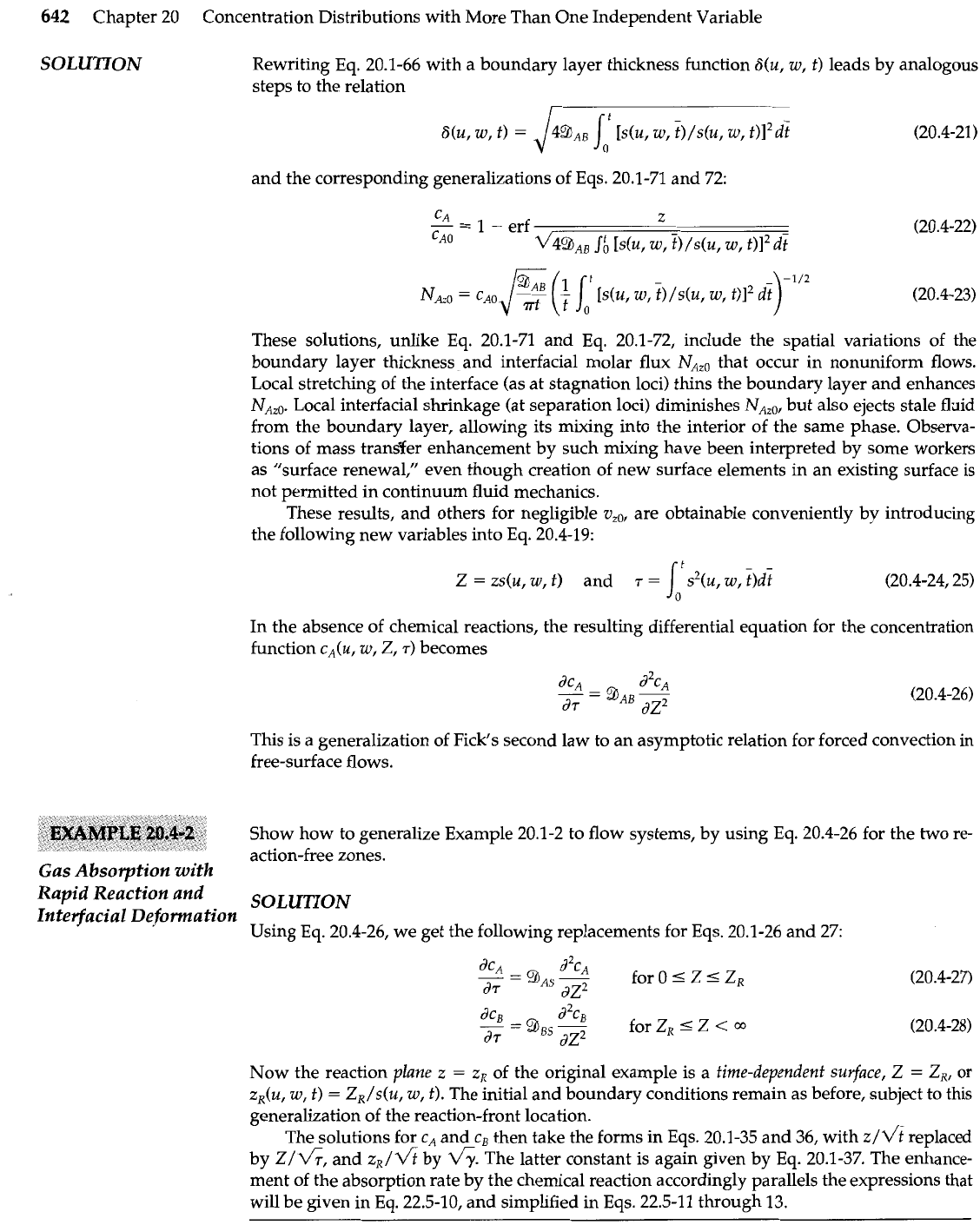
642
Chapter 20 Concentration Distributions with More Than One Independent Variable
SOLUTION
Rewriting Eq. 20.1-66 with a boundary layer thickness function Nu, w, t) leads by analogous
steps to the relation
EXAMPLE
20.4-2
Gas Absorption with
Rapid Reaction and
Intetfacial Deformation
and the corresponding generalizations of Eqs. 20.1-71 and 72:
CA
--
z
-
1
-
erf (20.4-22)
c~~
d4?bAB
Sb
[s(u,
Wr
~)/s(u,
W/
t)12
di
These solutions, unlike Eq. 20.1-71 and Eq. 20.1-72, include the spatial variations of the
boundary layer thickness and interfacial molar flux NAZO that occur in nonuniform flows.
Local stretching of the interface (as at stagnation loci) thins the boundary layer and enhances
NAzO. Local interfacial shrinkage (at separation loci) diminishes NAz0, but also ejects stale fluid
from the boundary layer, allowing its mixing into the interior of the same phase. Observa-
tions of mass transler enhancement by such mixing have been interpreted by some workers
as "surface renewal," even though creation of new surface elements in an existing surface is
not permitted in continuum fluid mechanics.
These results, and others for negligible
v,,,
are obtainable conveniently by introducing
the following new variables into Eq. 20.4-19:
Z
=
ZS(U,
W, t) and
7
=
(20.4-24/25)
In the absence of chemical reactions, the resulting differential equation for the concentration
function c,(u,
w,
Z,
7)
becomes
This is a generalization of Fick's second law to an asymptotic relation for forced convection in
free-surface flows.
Show how to generalize Example 20.1-2 to flow systems, by using Eq. 20.4-26 for the two re-
action-free zones.
SOLUTION
Using Eq. 20.4-26, we get the following replacements for Eqs. 20.1-26 and 27:
Now the reaction plane
z
=
z, of the original example is a time-dependent suuface,
Z
=
Z,,
or
z,(u, w, t)
=
Z,/S(U,
W,
t). The initial and boundary conditions remain as before, subject to this
generalization of the reaction-front location.
The solutions for
c,
and cB then take the forms in Eqs. 20.1-35 and
36,
with z/lh replaced
by
z/G,
and
zR/~
by
qY.
The latter constant is again given by Eq. 20.1-37. The enhance-
ment of the absorption rate by the chemical reaction accordingly parallels the expressions that
will be given in Eq. 22.5-10, and simplified in Eqs. 22.5-11 through 13.
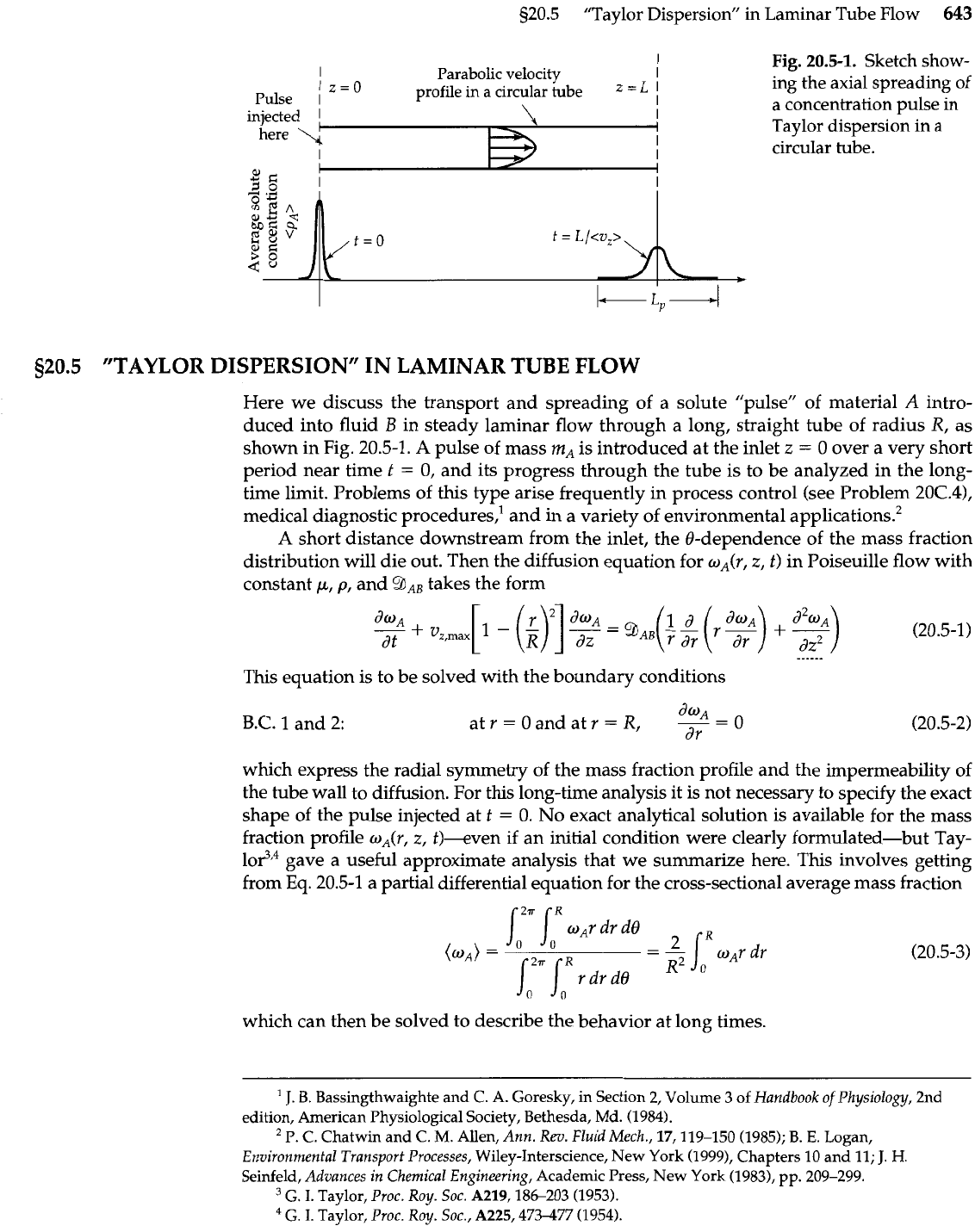
s20.5 "Taylor Dispersion" in Laminar Tube Flow
643
I
Fig.
20.5-1.
Sketch show-
I
Parabolic velocity
I
1
z=O profile in a circular tube
=
I
ing the axial spreading of
Pulse
injected
1
B\
1
a concentration pulse in
here
\
Taylor dispersion in a
circular tube.
t
=
L/<vz>
520.5
"TAYLOR DISPERSION" IN LAMINAR
TUBE
FLOW
Here we discuss the transport and spreading of a solute "pulse" of material
A
intro-
duced into fluid
B
in steady laminar flow through a long, straight tube of radius
R,
as
shown in Fig. 20.5-1.
A
pulse of mass
m,
is introduced at the inlet
z
=
0 over a very short
period near time
t
=
0, and its progress through the tube is to be analyzed in the long-
time limit. Problems of this type arise frequently in process control (see Problem
20C.41,
medical diagnostic procedures,' and in a variety of environmental applications.2
A
short distance downstream from the inlet, the &dependence of the mass fraction
distribution will die out. Then the diffusion equation for oA(r,
z,
t) in Poiseuille flow with
constant
p,
p,
and
a,,
takes the form
This equation is to be solved with the boundary conditions
B.C.
1
and 2:
~WA
atr=Oandatr=R,
--
dr
-
0
(20.5-2)
which express the radial symmetry of the mass fraction profile and the impermeability of
the tube wall to diffusion. For this long-time analysis it is not necessary to speclfy the exact
shape of the pulse injected at
t
=
0. No exact analytical solution is available for the mass
fraction profile wA(r,
z,
t)-even if an initial condition were clearly formulated-but Tay-
l0$r4 gave a useful approximate analysis that we summarize here. This involves getting
from Eq. 20.5-1 a partial differential equation for the cross-sectional average mass fraction
which can then be solved to describe the behavior at long times.
'
J.
B. Bassingthwaighte and
C.
A. Goresky, in Section
2,
Volume 3 of
Handbook of Physiology,
2nd
edition, American Physiological Society, Bethesda, Md. (1984).
P.
C.
Chatwin and
C.
M.
Allen,
Ann.
Rev.
Fluid Mech.,
17,119-150 (1985); B.
E.
Logan,
Environmental Transport Processes,
Wiley-Interscience, New York (1999), Chapters 10 and 11;
J.
H.
Seinfeld,
Advances in Chemical Engineering,
Academic Press, New York (1983),
pp.
209-299.
G.
I. Taylor,
Proc. Roy. Soc.
A219,186-203 (1953).
G. I. Taylor,
Proc. Roy. Soc.,
A225,473-477 (1954).
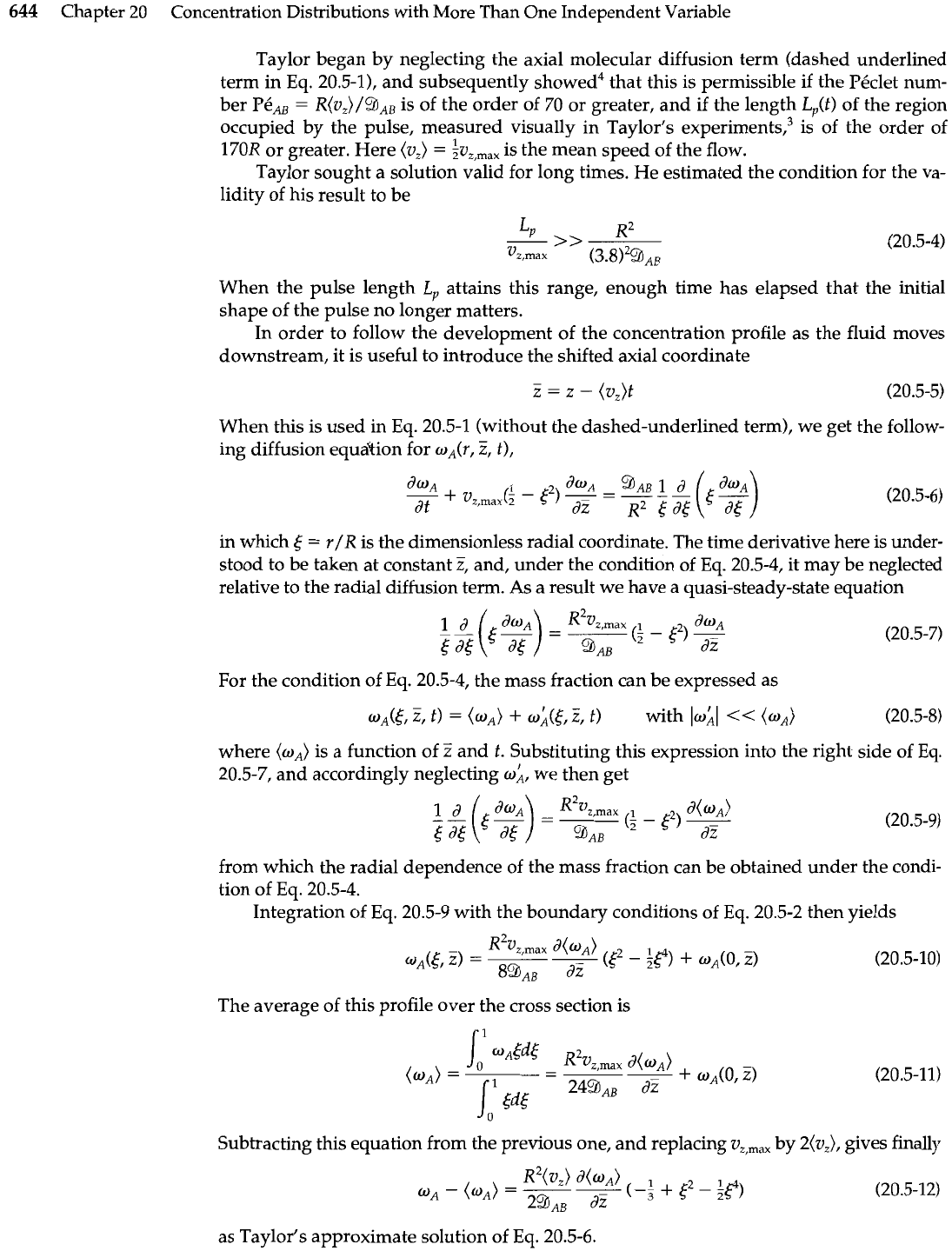
644
Chapter
20
Concentration Distributions with More Than One Independent Variable
Taylor began by neglecting the axial molecular diffusion term (dashed underlined
term in Eq. 20.5-I), and subsequently showed4 that this is permissible if the P6clet num-
ber PhAB
=
R(vZ)/9IAB is of the order of 70 or greater, and if the length
Lp(t)
of the region
occupied by the pulse, measured visually in Taylor's experimentsf3 is of the order of
170R or greater. Here (v,)
=
$v,,,,~
is the mean speed of the flow.
Taylor sought a solution valid for long times. He estimated the condition for the va-
lidity of his result to be
When the pulse length
Lp
attains this range, enough time has elapsed that the initial
shape of the pulse no longer matters.
In order to follow the development of the concentration profile as the fluid moves
downstream, it is useful to introduce the shifted axial coordinate
When this is used in Eq. 20.5-1 (without the dashed-underlined term), we get the follow-
ing diffusion equalion for wA(rf
Z,
t),
in which
6
=
r/R is the dimensionless radial coordinate. The time derivative here is under-
stood to be taken at constant
2,
and, under the condition of Eq. 20.5-4, it may be neglected
relative to the radial diffusion term. As a result we have a quasi-steady-state equation
For the condition of Eq. 20.5-4, the mass fraction can be expressed as
where (w,) is a function of
2
and
t.
Substituting this expression into the right side of
Eq.
20.5-7, and accordingly neglecting wi, we then get
from which the radial dependence of the mass fraction can be obtained under the condi-
tion of Eq. 20.5-4.
Integration of Eq. 20.5-9 with the boundary conditions of Eq. 20.5-2 then yields
The average of this profile over the cross section is
fl
Subtracting this equation from the previous one, and replacing
v,,,,,
by 2(vz), gives finally
as Taylor's approximate solution of Eq. 20.5-6.
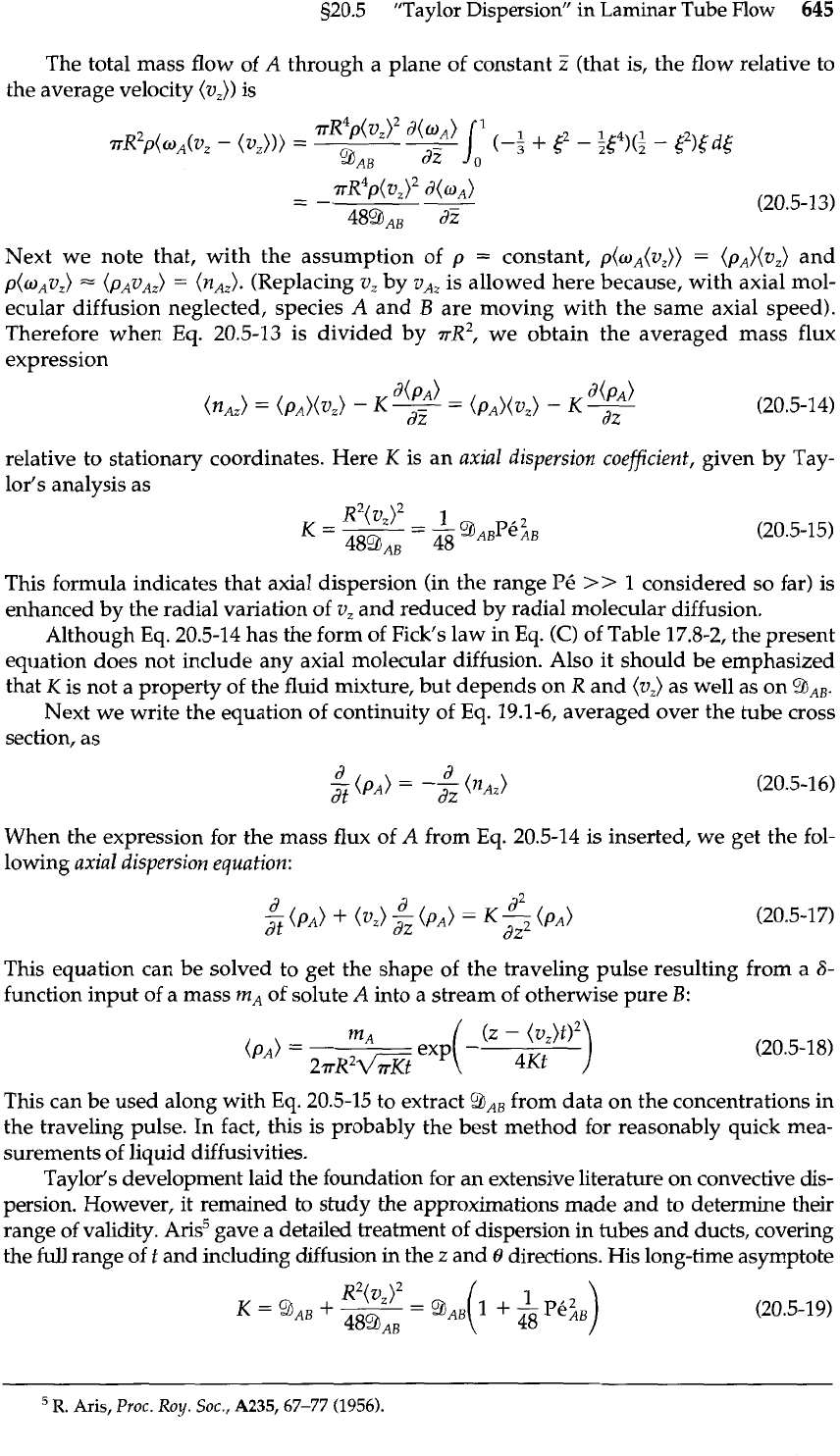
520.5
"Taylor Dispersion" in Laminar Tube Flow
645
The total mass flow of
A
through a plane of constant
Z
(that is, the flow relative to
the average velocity
(v,))
is
Next we note that, with the assumption of
p
=
constant,
p(wA(vz))
=
(pA)(v,)
and
p(oAvz)
=
(pAvA,)
=
(nAz).
(Replacing
v,
by
VAz
is allowed here because, with axial mol-
ecular diffusion neglected, species
A
and
B
are moving with the same axial speed).
Therefore when Eq. 20.5-13 is divided by
TR~,
we obtain the averaged mass flux
expression
relative to stationary coordinates. Here
K
is an
axial
dispersion coefficient, given by Tay-
lor's analysis as
This formula indicates that axial dispersion (in the range
P6
>>
1
considered so far) is
enhanced by the radial variation of
v,
and reduced by radial molecular diffusion.
Although Eq. 20.5-14 has the form of Fick's law in Eq.
(C)
of Table
17.8-2,
the present
equation does not include any axial molecular diffusion. Also it should be emphasized
that
K
is not a property of the fluid mixture, but depends on
R
and
(v,)
as well as on
%,,.
Next we write the equation of continuity of Eq. 19.1-6, averaged over the tube cross
section, as
When the expression for the mass flux of
A
from Eq. 20.5-14 is inserted, we get the fol-
lowing
axial
dispersion equation:
This equation can be solved to get the shape of the traveling pulse resulting from a
6-
function input of a mass
m~
of solute
A
into a stream of otherwise pure
B:
This can be used along with Eq. 20.5-15 to extract
gAB
from data on the concentrations in
the traveling pulse. In fact, this is probably the best method for reasonably quick mea-
surements of liquid diffusivities.
Taylor's development laid the foundation for an extensive literature on convective dis-
persion. However, it remained to study the approximations made and to determine their
range of validity. ~ris~ gave a detailed treatment of dispersion in tubes and ducts, covering
the full range of t and including diffusion
in
the
z
and
0
directions. His long-time asymptote
R.
Aris,
PYOC.
Roy.
SOC.,
A235,67-77
(1956).
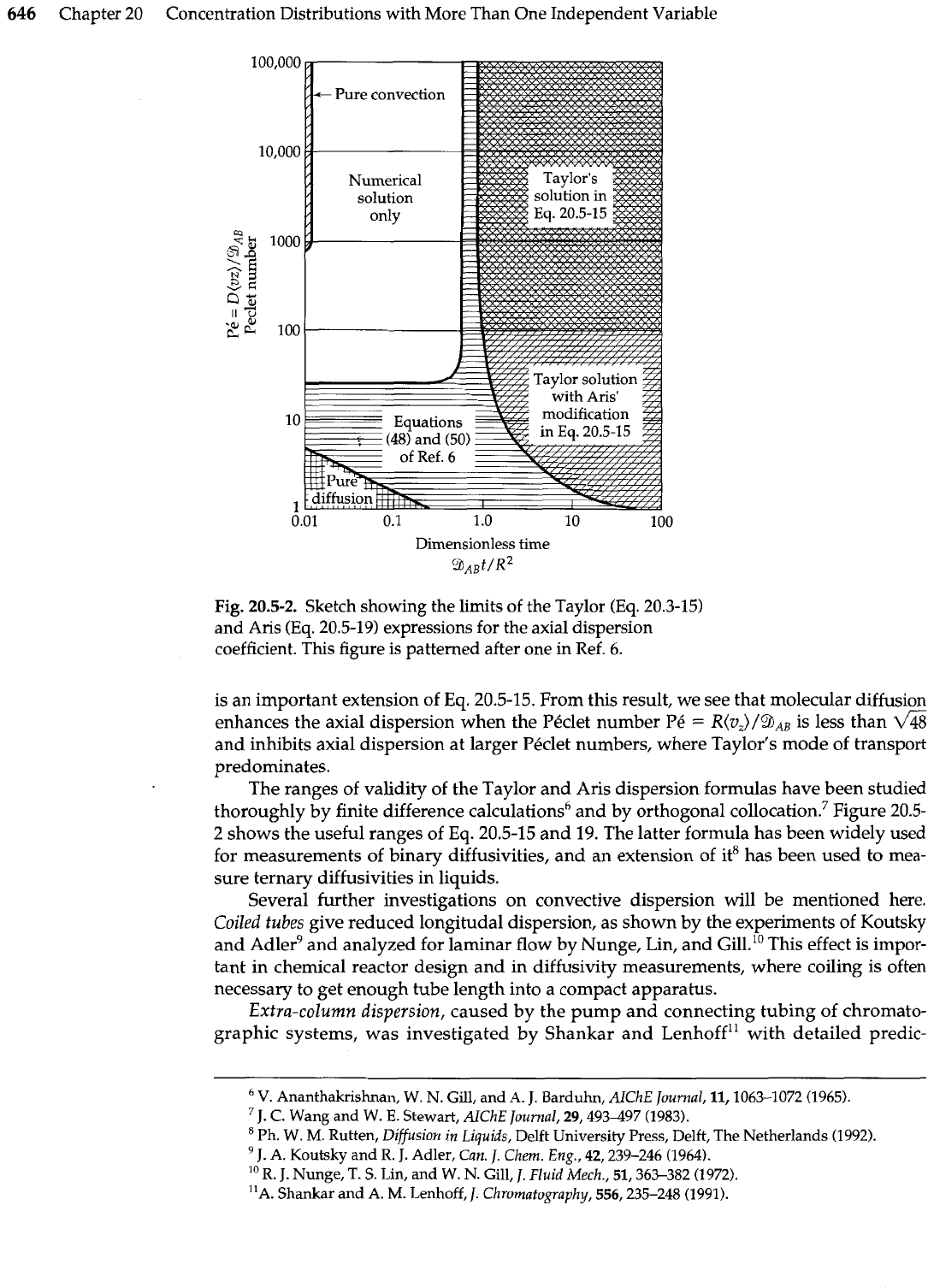
646
Chapter 20 Concentration Distributions with More Than One Independent Variable
.01 0.1 1.0 10 100
Dimensionless time
QA~t/~'
Fig.
20.5-2.
Sketch showing the limits of the Taylor
(Eq.
20.3-15)
and Aris
(Eq.
20.5-19) expressions for the axial dispersion
coefficient. This figure is patterned after one in Ref.
6.
is an important extension of
Eq.
20.5-15. From this result, we see that molecular diffusion
enhances the axial dispersion when the Pkclet number Pk
=
R(V,)/%~
is less than
V'%
and inhibits axial dispersion at larger Peclet numbers, where Taylor's mode of transport
predominates.
The ranges of validity of the Taylor and Aris dispersion formulas have been studied
thoroughly by finite difference calculationsb and by orthogonal coll~cation.~ Figure
20.5-
2 shows the useful ranges of
Eq.
20.5-15 and
19.
The latter formula has been widely used
for measurements of binary diffusivities, and
an
extension
of
it8 has been used to mea-
sure ternary diffusivities in liquids.
Several further investigations on convective dispersion will be mentioned here.
Coiled tubes
give reduced longitudal dispersion, as shown by the experiments of Koutsky
and Adler9 and analyzed for laminar flow by Nunge, Lin, and Gill.'' This effect is impor-
tant in chemical reactor design and in diffusivity measurements, where coiling is often
necessary to get enough tube length into a compact apparatus.
Extra-column
dispersion,
caused by the pump and connecting tubing of chromato-
graphic systems, was investigated by Shankar and ~enhoff" with detailed predic-
V.
Ananthakrishnan, W.
N.
Gill,
and A.
J.
Barduhn,
AlChE Journal,
11,1063-1072 (1965).
J.
C.
Wang and
W.
E.
Stewart,
AKhE Journal,
29,493497 (1983).
Ph. W.
M.
Rutten,
Diffusion
in Liquids,
Delft University Press, Delft, The Netherlands
(1992).
J.
A. Koutsky and
R.
J.
Adler,
Can. J. Chem.
Eng.,
42,239-246 (1964).
lo
R.
J.
Nunge,
T.
S.
Lin, and W.
N.
Gill,
1.
Fluid Mech.,
51,363-382 (1972).
"A. Shankar and A.
M.
Lenhoff,
J.
Chromatography,
556,235-248 (1991).
